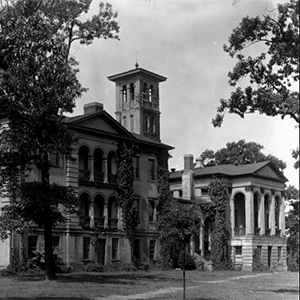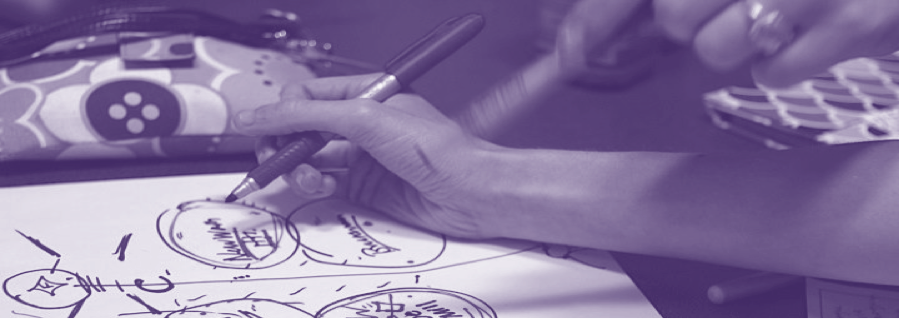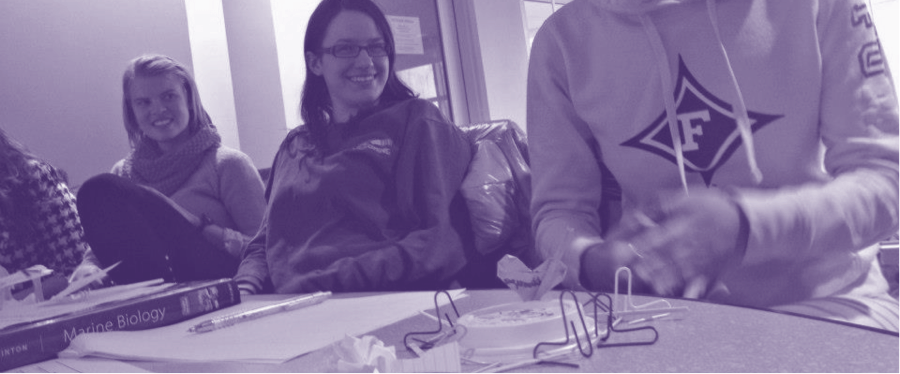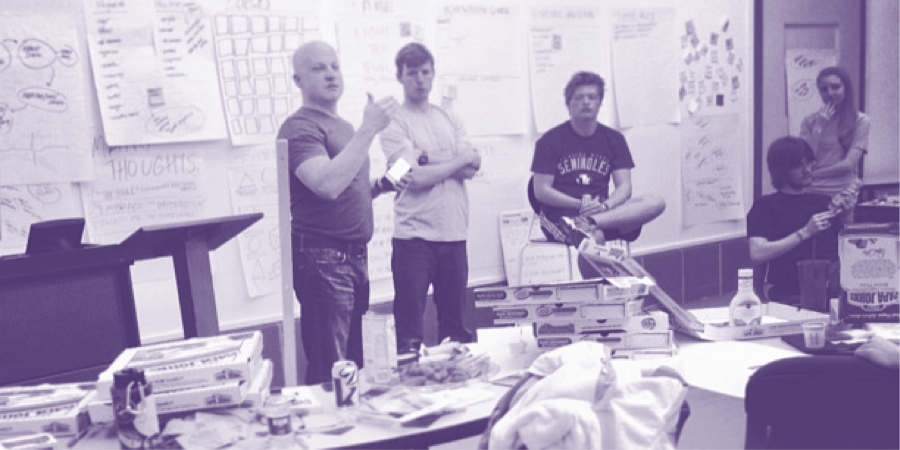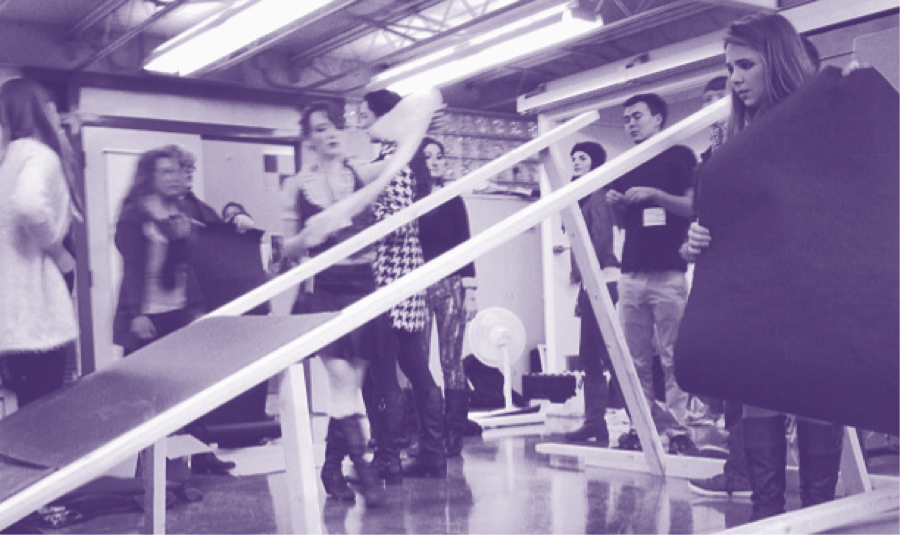Organization:Furman on FIRE - Fueling Innovation Research & Entrepreneurship
Contents
- 1 Furman on FIRE
- 2 A History of Engaged Learning
- 3 Inspiration for a Movement
- 4 Ecosystem of Assets & Opportunities
- 5 A Strategy for Collective Impact
- 6 Sparking a Grassroots Movement
- 7 Strategic Project on Innovation & Creativity
- 8 Short Term Project
- 9 Long Term Project
- 10 Related Links
- 10.1 Furman University Campus Wiki
- 10.2 Furman University Student Priorities
- 10.3 Furman Innovation & Entrepreneurship Landscape Canvas
- 10.4 Ben Riddle, Furman University Innovation Fellow
- 10.5 Tyler Higgins, Furman University Innovation Fellow
- 10.6 Sam Kristen Can, Furman University Innovation Fellow
- 10.7 Furman University Website
- 10.8 TEDxFurmanU
Furman on FIRE
Fueling Innovation, Creative Research and Entrepreneurship at Furman - a leading liberal arts University.
Since its founding in 1826, Furman has equipped doers, thinkers and creatives with tools to understand the past, embrace the present and build a better future. Inspired by this rich tradition, how might we fuel a movement of innovation, creativity and entrepreneurship that links the liberal arts and humanities with the sciences to create sustainable solutions for the grand challenges of our times?
At Furman, students, faculty, administrators and alumni are breaking boundaries and crossing disciplines to ask bold questions about the role of the university in an age of constant change. How might we equip learners of all ages with tools for navigating uncertainty and bringing ideas to life? How might we put theory into practice by engaging the community in new ways? How might we work together across disciplines to create solutions that have real-world impact? By using tools like design thinking and social entrepreneurship as strategies for engaged learning, we're creating a strategy and vision that will move Furman forward. Join us.
A History of Engaged Learning
In 1937, Furman University President Bennette Geer partnered with John D. Rockefeller’s General Educational Board to bring a new form of lifelong learning to the Southeast through the Greenville County Council for Community Development (GCCCD). Inspired by the work of a Columbia University doctoral student, Geer led the university to develop an experimental design for community-centered improvement program that married town and gown in a whole new way. The vision for this initiative was steered by a coalition of faculty and students from Furman’s Sociology, Political Science, and Education Departments and a 24-person “County Council,” that included governmental officials, presidents of service organizations and educational leaders. During this period of Furman's history, teachers used innovative teaching methods that crossed institutional, racial and socioeconomic boundaries to put theory into practice. A course taught on farm mechanics built flues for houses in low-income communities. Agriculture classes visited Clemson University’s model farm and learned to build “hog homes". Other community-based projects included surveys of mill village hygienic facilities and conditions at rural black schools, support for community-wide vaccinations, improved health services, food preservation and lifelong learning (Bainbridge, 2010).
While halted during World War II, it was re-started in 1946 under Greenville City Schools and the Adult Education Division of the State Department of Education. Today, Furman still stands strong as a center for engaged research, creative problem solving and lifelong learning through the efforts of the Herring Center for Continuing Education, the Riley Institute, the Shi Center for Sustainability and a host of other faculty and student-led initiatives.
Inspiration for a Movement
In light of Furman's historical commitment to engaged learning, members of the university community are coming together in new ways to imagine a future where creativity, innovation and entrepreneurship are more than words on a page. Furman's strong focus on undergraduate research, faculty-student relationships and community engagement sets precedence for a movement of thought and action that brings together the disciplines to create experiences that equip students of all ages with the tools for solving the grand challenges of our times. Through this movement, Furman will stand firm in its identity as a leading liberal arts institution and give new meaning to engaged learning.
Ecosystem of Assets & Opportunities
When looking towards the existing ecosytem of assets on campus, Furman has a number of existing initiatves that foster innovation and creativity across campus - setting it apart from others that are similar in size. Courses like Entrepreneurship and New Venture Development, Graphic Design, Advertising Design and Design for Social Change lead to the development of venture concepts that are incubator-ready – and in some cases – ready to launch. Faculty-Student research and co-curricular projects stemming from the Shi Center for Sustainability have led to the development of social ventures like the Community Conservation Corps, Mill Village Farms: a network of urban farms that equip underserved youth with farming and entrepreneurial skills, and Good to Go Greenville: a mobile market that provides access to fresh produce in food deserts across the county.
Through the Furman Advantage program, many sophomores, juniors and seniors are engaging in internships that introduce them to innovation, entrepreneurship and creative practice. In addition, student organizations like Furman Creative Collaborative are planting seeds for a movement of entrepreneurship, innovation and creativity on campus by hosting design thinking workshops and planning events like TEDxFurmanU and 3 Day Startup.
With this said, the infrastructure for Furman's innovation ecosystem leaves plenty of opportunities for growth and development. Few intiatives on campus allow students to apply what they are learning through experiences that lead to tangible outcomes. In addition, there are no central places on campus for students to access tools, training and support needed to develop new ventures, projects and organizations that make a real-world impact.
While assessing the innovation ecosystem on campus, students pointed towards peers that were creating apps, launching social ventures and starting companies in their dorm rooms. When asked to comment on the entrepreneurial community on campus, these students mentioned that they aren’t surrounded with peers and mentors that can nurture their ideas and grow them to scale. At the same time, students in the art and business departments are creating venture concepts for class that are viable and compelling, but need further development. Since students have no place to take their projects after the class ends, many plateau or are terminated due to lack of time, committment and support. These students mentioned that a network of peer collaborators was desired, along with access to capital, alumni mentors and dedicated time and space for venture development. Others mentioned that they would like see a student incubator, a student venture fund and start-up training programs take root on campus in the years ahead.
At the curricular level, faculty from Earth and Environmental Science, Philosophy, Art, Business and Sustainability Science have all expressed interest in integrating concepts related to creativity, innovation and entrepreneurship into their existing courses. Several of these faculty have expressed interest in creating team-taught courses that bring students from different disciplines together to solve real-world problems. In addition, staff members at the Center for Teaching and Learning and the Shi Center for Sustainability mentioned that they would be interested in developing a professional development program to equip faculty with strategies, tools and curricular resources for course integration. With this said, faculty and staff have mentioned that the currrent structure of the semseter leaves them with little time, energy and resouorces to devote to efforts like this.
A Strategy for Collective Impact
In order to bring these ideas to life and redefine the liberal arts at Furman, a three-fold strategy will be employed.
1) Grassroots Movement: A grassroots movement will be developed to spur interest on campus and equip all members of the university community with the tools for introducing creativity, entrepreneurship and innovation at all levels of university activity. This movement will be facilitated by the University Innovation Fellow and the Fire Circle: an inclusive coalition of faculty, staff and students.
2) Strategic Vision: A Strategic Project on Innovation and Creativity will be created by the coalition to set an agenda for creativity and innovation on campus and guide future activity. The University Innovation Fellow will work on a yearly basis to convene the group and facilitate the implementation of the vision in partnership with faculty sponsors, trustee partners and the University Innovation Fellowship network.
3) Place-Based Innovation: In order to equip students and faculty with the tools, skillsets and resources outlined in the vision, the coalition will work towards the development of an Institute for Design Thinking and Social Innovation that serves as a central hub for creativity, innovation and entrepreneurship on campus. This Institute will house a student venture incubator, an accessible maker space and flexible classrooms for team-taught design thinking courses, professional development workshops and lifelong learning programs.
Sparking a Grassroots Movement
Furman on FIRE
In order to ensure that the movement is sustainable and inclusive, a three-tiered network will be created to equip all members of the university community with the tools for introducing creativity, entrepreneurship and innovation at all levels of campus activity.
1) Fire Circle: This group stewards the vision for innovation, creativity and entrepreneurship on campus by creating the Strategic Project plan and keeping track of activity in each focus area. The Fire Circle is comprised of student leaders, faculty sponsors, academic deans, alumni and trustees that are interested in fostering innovation activity on campus. Each member of the Fire Circle is responsible for championing a particular focus area and recruiting Fire Starters to generate interest through established networks on campus. This group functions as the "brain trust" for the movement.
2) Fire Starters: This group of students and faculty work together to plan events and activities in each focus area to spread the vision across campus. As word-of-mouth marketing agents, Fire Starters spark interest among friends and connect their peers with opportunities to engage in each focus area. These are the "first followers" of the movement.
3) Fire Sparks: This group includes all members of the Furman community - students, faculty, staff or alumni – that engage in the movement of innovation, creativity and entrepreneurship. Fire Sparks pursue their passions by taking experiential courses, engaging in community service, pursuing innovative research, starting creative projects or taking action on their ideas through entrepreneurship.
Empowering Agency: In order to ensure that the movement spreads across the campus community, all students and faculty involved work towards the development of opportunities that empower students to
A) Find their Spark: The passions, interests, visions and hopes for the future that lead them to make their mark in the world.
B) Develop their Skills: The unique talents, gifts and creative capacities that set them apart and make them an asset to any team.
C) Build a Network: The relationships with peers, mentors and community members that lead to new insights and opportunities.
Working from the Grassroots to the Treetops
In order to ensure that the movement gains traction, the Fire Circle will focus their efforts on initiatives that take place at every level of university activity - from the "grassroots" to the "treetops".
Grassroots
Fire Circle Meetings - gathering students, faculty and staff that are working behind the scenes to further the movement.
Events, Conferences & Workshops - student-organized events, faculty-sponsored conferences and skill-building workshops that introduce innovation, creativity and entrepreneurship to the campus community.
Classes & Programs - living-learning communities, cross-diciplanary courses, creative problem-solving workshops and continuing education courses that create space for students of all ages to aquire skills that foster creativity, innovation and entrepreneurship through credit-bearing, certificate and informal courses.
Community Partnerships - collaboration with community partners to create new internships, fellowships and co-op experiences that foster creativity, innovation and entrepreneurship across the university community.
Structural Changes - creation of new university structures that create space for faculty-led innovation projects, along with an institute that is responsible for working across campus to develop new courses and initiatives, assess outcomes and ensure the sustainabilty of the movement on campus.
Cross Institutional Collaboration - strategic partnerships with universities across the state, around the region and around the nation to integrate the principles of entrepreneurship, innovation and creative-problem solving into the fabric of society - from the chambers of the statehouse to small towns across the state.
Treetops
Building a Portfolio of Small Bets
Rather than planning an entire project or starting with a big idea, entrepreneur and author Peter Sims argues that organizations should create a set of small experiments that are designed to inform larger goals. According to Sims, "A little bet is a low-risk action taken to discover, develop, and test an idea. So, for instance, Chris Rock develops new comedy routines by making little bets with small audiences, while Amazon’s CEO Jeff Bezos makes small bets to identify opportunities in new markets. Little bets are at the center of an approach to get to the right idea… without getting stymied by perfectionism, risk-aversion, or excessive planning."
In order to make progress on expanding the entrepreneurship and innovation ecosystem at Furman, a portfolio of small bets should be created in order to test assumptions and inform next steps in a way that makes use of existing assets and resources. Such small bets could include:
New Post Graduate Fellowships and Internships:
How might we build upon the Furman Advantage Program to create new opportunities for students to explore entrepreneurship and innovation through internships and post-graduate fellowships?
- Tinderbox: In partnership with Brains on Fire & CreateAthon, this student-run branding agency could partner with local organizations to complete pro-bono design projects and consult non-profit clients on current communications, fundraising and word-of-mouth marketing strategies. By working through the Art Department and the Office of Internships, Tinderbox could feature semester and yearlong internships, summer fellowships and other engaged learning opportunities.
- The Forge: In partnership with the Center for Teaching and Learning's Studio Lab (CTL), ITS and the Robotics Club, this campus maker space and tech studio could create opportunities for students to connect with faculty and community partners around shared interests in maker culture, computer science, technology and design. The Forge could feature semester and yearlong internships, summer fellowships and other engaged learning opportunities.
- FutureLab: In partnership with the Shi Center for Sustainability and the Riley Institute, this student-run service design group could work with public sector organizations and service providers to understand complex problems, visualize systems and develop real-world solutions for critical local issues. FutureLab could feature semester and yearlong internships, summer fellowships and other engaged learning opportunities.
- POP Studio: In partnership with Indie Craft Parade and the Furman Art Department, this student-run design studio could partner with local communities to create community-based art and mural projects, facilitate creative problem solving and create pop-up events that spur grassroots economic development. POP Studio could features year-long internships, summer fellowships, extracurricular and co-curricular opportunities
Engaging Student Organizations:
How might student organizations integrate entrepreneurship, design and creativity into their events and activities in order to spread the movement through existing student networks?
Furman Creative Collaborative: This student organization functions as a think-and-do tank that equips students from across campus with tools, space and a community of support to bring ideas to life. In the years ahead, FCC satellite groups will include TEDxFurmanU, Fine Arts Entrepreneurial Society, POP Studio, WPLS Radio, Startup @ Furman, Design for America and others.
New Living-Learning Communities:
How might we build upon the Engaged Living program to create new living-learning communities that creates space for students to explore creativity, entrepreneurship and innovation outside of classes and clubs?
- Engaged Living by Design: This signature freshman experience could include two seminars (design thinking and creativity, social entrepreneurship for public good) one class (computer science, poverty studies, urban sociology, sustainability science, business), co-curricular (student projects on campus) and extra-curricular (FCC, DFA, etc.) opportunities.
- The Hub @ FU: This signature upperclassman living experience creates space for juniors and seniors interested in entrepreneurship, computer science and graphic design to live in a startup-themed living-learning community in the North Village Apartments. This community could feature co-curricular (student projects on campus) and extra-curricular opportunities linked to relevant coursework (Business, Art, Computer Science).
- The Greenbelt @ Furman Lake: This signature engaged-living experience creates space for sophomores, juniors and seniors interested in sustainability, technology, social entrepreneurship and design to live in a sustainability-themed living-learning community on Furman Lake. This community could feature co-curricular (student projects on campus) and extra-curricular opportunities linked to relevant coursework (Sustainability, Art, Business, Earth & Environmental Science, etc.).
- Community House: This signature engaged-living experience creates opportunities for juniors and seniors in Furman's Poverty Studies program to live in a community house on the Poinsett Corridor that focuses on social innovation, community development and grassroots leadership. This could include after-hours seminars, related courses (Poverty Studies, Economics, Business, Art, Sociology, Sustainability Science, etc.), co-curricular (student projects on campus) and extra-curricular opportunities.
Strengthened Partnerships with Greenville:
How might we connect with partners across the region to bring the conversation around innovation and entrepreneurship to campus
The Makery Project: In the fall of 2014, the Furman Art Department acquired a vacant 1000 square foot storefront in the Sans Souci neighborhood. This space will serve as a laboratory for student creativity and innovation and a "small bet" to demonstrate the value of I & E to university and community leaders. This space, deemed The Makery, will also be a bridge between campus and community, allowing students to interact with creators and innovators from Sans Souci and the Greater Greenville area. Future plans include turning an adjacent screen printing shop into a cross-disciplinary, student-operated venture to expose students to real-life business and creative principles.
The Iron Yard & NEXT Innovation Center: In semesters ahead, Furman could partner with the Iron Yard to create new events and opportunities that introduce faculty and students to the accelerator's startup culture. In addition, the NEXT Innovation Center could offer exciting opportunities for Furman students to apply what they’re learning in real time by working through internships and fellowships.
Clemson MBA Program: How might we connect undergraduate students at Furman with graduate students in Clemson’s MBA program through projects and events hosted on campus and in downtown Greenville? These events could be framed around solving community problems and designing real-world solutions that make an impact.
Faculty-Student Learning Communities:
How might we create space for faculty and students to explore emergent trends in entrepreneurship, innovation, creativity and technology through open learning communities and online courses?
Expanded May Experience Programs:
How might we wencourage faculty to create May Experience courses that introduce innovation, entrepreneurship and design thinking to students across disciplines?
Expanded ICP - Individual Curriculum Program:
How might we build upon the interdisciplinary curriculum program to allow more students to create their own course of study that ends in a senior capstone experience that integrates creative problem solving, entrepreneurship, innovation or research that leads to / supports technological innovation?
Beginning sophomore year, students begin to explore their interests and craft their disciplinary pursuits into an ICP proposal. As a component of this proposal, students will choose an area of focus where they will identify a problem or opportunity and design a meaningful solution.
Junior and senior years, students will be equipped with tools and skillsets to create their solution through courses that explore opportunity assessment and project management, foundations of entrepreneurship, start-up finance, business model canvasing, product development, management and investment strategies.
At the end of the senior year, students will test and refine their solution, ending the year with a pitch to fellow ICP participants, community members, entrepreneurs from the community and potential investors.
Strategic Project on Innovation & Creativity
How might we infuse the principles of innovation, entrepreneurship and creative problem-solving into all levels of university activity?
This strategic project will be co-developed and coordinated by a coalition of partners from across the university - the Fire Circle. Below, seven dimensions are outlined to serve as benchmarks for embedding creativity, entrepreneurship, design and innovation into existing institutional assets through a series of conceptual programs, projects and experiences.
Engaged Teaching & Learning
- Offer a variety of high-quality courses that build the creative capacities of students. Courses might explore design thinking, human-centered design, creative problem solving, design for sustainability, design for social sustainability, policy design, service design, design for extreme affordability, negotiation and collaboration, group facilitation, graphic visualization of data sets, social innovation and social entrepreneurship.
- Introduce a minor or certificate in creative leadership, social innovation and public interest design - Integrate the concepts of creativity and social innovation and the methods of design thinking into courses across disciplines.
- Nurture and encourage the capacities of creativity and social innovation among a significant number of students and faculty through workshops, seminars, courses and co-curricular experiences.
Engaged Research & Development
- Establish a campus design consultancy that takes a human-centered, design-based approach to helping organizations on campus, in the community and in public and private sectors innovate and grow. This consultancy might work with administrators, faculty and student organizations to create new programs, policies, products, services, spaces, and experiences that serve the needs of people and contribute to the development of the whole person. This consultancy should also work with organizations to create systems that foster collaboration, sustain innovation and advance positive change.
- Encourage faculty to engage in applied research that advances the study of empathy, creativity, facilitation, human-centered design, social innovation and social entrepreneurship.
Engaged Application
- Establish relationships with organizations and companies that recruit graduates for internships and full-time positions that engage students in entrepreneurship, social innovation, human-centered design and creative practice.
- Seek out and publicize internship opportunities for students, with emphasis on entrepreneurship, social innovation and creative practice.
- Create opportunities for students to engage in start-up competitions, social innovation challenges, service learning and civic engagement opportunities focused on problem analysis, empathic observation, social advocacy and public interest design.
Engaged Opportunity
- Create long-term funding for faculty and staff roles that advance creative practice and social innovation in campus.
- Seek out funding for both student and faculty projects; offer prizes and awards for innovative work, projects and competitions
- Provide access to inspiring, flexible classroom and collaboration spaces for work on individual or group projects; provide students and faculty with access to an incubator and accelerator program for new social ventures.
Engaged Network
- Develop ongoing relationships with leading design practitioners and social innovators to serve as role models / mentors for students and faculty; invite role models, mentors and guest practitioners to present in a Cultural Life Program annually.
- Spotlight key alumni changemakers, entrepreneurs and social innovators as role models, mentors and case studies through events or other channels.
Engaged Culture & Community
- Produce benchmarks and deliverables that provide evidence that the institution attracts, supports and celebrates changemakers who engage in intellectual risk-taking, creative problem-solving and social innovation.
- Create a national, regional and local advisory council with an executive leadership team and a network of campus catalysts to ensure accountability and transparency of the project.
- Support integration across the campus and create structural frameworks to ensure continuty, despite any leadership changes.
Engaged Student Experience
- Create a series of experiences for undergraduates, graduates and alumni to pursue their passions through:
- an encouraged gap year for personal exploration
- an orientation experience that introduces creativity and innovation during the first week on campus
- a robust May Experience Program that offers problem-based courses in designing solutions for real-world problems.
- an optional 5th-Year engage.d institute experience that trains graduates in design thinking & social entrepreneurship through 2 semesters of applied course-work
- a series of lifelong learning programs that bring alumni together around problem-based learning and creative problem-solving
Short Term Project
The Makery
Overview:
In the fall of 2014, the Furman Art Department acquired a vacant 1000 square foot storefront in the Sans Souci neighborhood. This space will serve as a laboratory for student creativity and innovation and a "small bet" to demonstrate the value of I & E to university and community leaders. This space, deemed The Makery, will also be a bridge between campus and community, allowing students to interact with creators and innovators from Sans Souci and the Greater Greenville area. Future plans include turning an adjacent screen printing shop into a cross-disciplinary, student-operated venture to expose students to real-life business and creative principles.
Phases:
EXPERIMENT (Fall 2014): The initial phase in The Makery project will serve as an experimental period to determine best practices and shape the future vision of the initiative. The space will host a variety of student and community events in order to increase exposure and create interest. These events might include art galleries, pop up retail, performances, or workshops. Students will also work with Marshall Jacskon, the owner of the building and the adjacent Screen Tech printing shop to learn the craft and business of screen printing.
TRANSITION (Spring 2015): In this phase, the project will use the insights collected from Phase 1 to transition The Makery into its long term model, whatever that may be. At this point in the project, the goal will be to move toward, if not achieve, economic self-sufficiency through event rental fees, entrance fees, and other possible revenue streams. Also in this phase, the transference of day to day operations of Screen Tech will need to be explored.
SUSTAIN (2015+): The ultimate goal of phases 1 and 2 will be to ideate and test possible operational models for The Makery space in order to reach the long-term operational model that will form Phase 3. Possibilities include a community-owned and operated venture, a Furman-owned and operated venture, or even a student-owned and operated model. The current empty spaces will be converted into some combination of event space, maker/innovation space, and cafe/bakery amongst other ideas. The Screen Tech operation will be completely student-run and possibly separately owned. It will provide students from across disciplines the opportunity to practice the art of screen printing and gain experience in operating a real business venture.
Key Tactics:
Tactic 1: Utilize relationships with FCC and Roers (Furman Art) and develop relationships with other student groups in order to bring a broad base of students into the project
Tactic 2: Actively promote our presence in the community and invite input and programming from Sans Souci and Greenville stakeholders
Tactic 3: Maintain flexibility in all aspects of the project. The space should be able to transition from art gallery, to pop up retail, to performance venue with minimal work. Similarly, the project team should be able to pivot easily based on customer feedback and our own experiences
Long Term Project
engage.d institute: A Hub of Design Thinking & Social Innovation
Vision:
In alignment with Furman’s commitment to the liberal arts, the engage.d institute of Design Thinking and Social Innovation creates an environment where knowledge, passion and creativity intersect in a collaborative setting.
Engage.d is a living classroom where real-world problems are defined and sustainable solutions are developed with partners, stakeholders, users and experts. Through classes and extracurricular projects, students, professors and communtiy partners engage in a design thinking, a creative problem-solving methodology that combines creative and analytical approaches.
Students learn by defining problems that are based on fieldwork, uncovering the real human needs that they want to address. In cycling through the process multiple times on every project, students benefit from applying their knowledge outside the classroom in a collaborative setting and partners benefit by gaining new perspectives, new insights and new solutions.
In partnership with the Hasso Plattner Institue of Design at Stanford and a network of d.schools around the world, the engage.d institute brings design thinking to the undergraduate education in a meaningful way.
Focus Areas:
I) Education and Lifelong Learning
II) Health and Wellness
III) Social Innovation and Entrepreneurship
IV) Sustainability
V) Civic Innovation
Project Phases:
Phase I: Pilot design thinking on campus through existing programs by integrating the methodology into each of the Engaged Learning programs and offering a May Experience elective course in Design for Social Change, which introduces the methodology through Furman’s Art Department (Completed May 2013).
Phase II: Connect faculty, students, administrators, alumni and trustees to build a case for the development of the Engage.d Institute: a hub for cross-diciplanary courses, design thinking workshops, professional development programs, conferences and events that create a culture of innovation and entrepreneurship on campus.
Phase III) Partner with companies, organizations, schools and other universities to teach design thinking as a strategy for problem-solving and innovation.
I) K-12 Educator Training
II) Executive Training
III) Student Consulting
Space & Place:
I) Flexible Learning Space
Flexible classroom space with an open floor-plan. Includes movable high tables, stools, rolling whiteboards and a seminar-style focal seating area. Space to accommodate 40-50 people for classes and group meetings.
II) Active Classroom
A classroom with an open floor-plan, movable wall panels (T-walls) whiteboard walls and flexible seating. This space can be rented out for events.
III) Maker Space
An accessible space furnished with flexible furniture, workbenches, tools, supplies and prototyping materials.
IV) Incubator Space
Free incubator space for student social entrepreneurs, recent Furman graduates or Furman business students who are starting businesses that are related to the focus areas of the institute.
V) Collaboration Lab
Meeting space for 10-12 people, with flexible furniture, in a glass-enclosed room.

